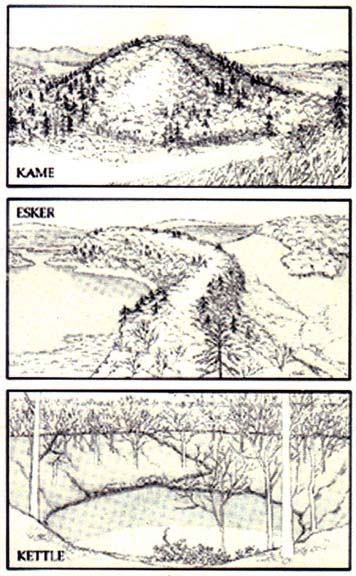Since I never took Earth Science I am going to refer you to several good resources about the remains left by the receding glaciers of the last Ice Age. There is a nice brochure published by the Monroe County Department of Parks about the the specific Glacial Geology at Mendon Ponds Parks. I will bring a few copies to the Dec 2 hike.
The following descriptions have been extracted from the references below.
Kame: Hill of stratified drift that forms when a stream deposits sediment in a hole in the glacial ice.
Kettle lake: This is essentially the opposite of a kame. When a block of glacial ice is stranded by a retreating glacier, it prevents sediments from being deposited. When it finally melts, a depression is left.
Esker: Streams flowing through, in and under the glacier carried much rock waste. Frequently these bits of sand and gravel mixed with boulders settled in the stream channel. When the ice melted there was nothing to hold them in place and they slumped to form long, sinuous, roughly stratified hills.
Drumlin: A glacier picks up and carries rock material. This probably accumulated along the edge of the ice sheet. Ice pushing against it probably rode up and over it shaping it into elongate, oval hills called drumlins. Drumlins probably developed as the ice sheet pushed southward.
Moraine: As a glacier started to melt, the melting ice furnished great quantities of rock material, which streams, emanating from the ice, dropped along the front edge of the ice sheet. The great piles of waste material accumulated in what is known as a terminal moraine.
 A brief history of Mendon contains this picture of the three major geological formations at Mendon Ponds. This history explains that Mendon Ponds Park was purchased by Monroe County in 1928 based on recommendations from Herman L. Fairchild, Professor of Geology at the University of Rochester.
A brief history of Mendon contains this picture of the three major geological formations at Mendon Ponds. This history explains that Mendon Ponds Park was purchased by Monroe County in 1928 based on recommendations from Herman L. Fairchild, Professor of Geology at the University of Rochester.
Take a look at the lecture on Continental glaciers and Ice ages from the Geology 100 course at the University of Maryland for a quick description of several features created by a receding glacier including Drumlins, Eskers, Kames and Kettle lakes. Apparently, Drumlins and Moraines are not present at Mendon ponds, but can be seen in this area (for example, Hill Cumorah in Palmyra is a Drumlin and several moraines are visible in Dansville).
The Rochester Academy of Sciences website contains several other articles about glaciers. Simply search for Glacier on the site. You can also check Wikipedia for additional explanations of these formations. If you know a reference that explains how Glaciers and the Ice Age helped form the Finger Lakes, please leave a comment. I would love to know more.
